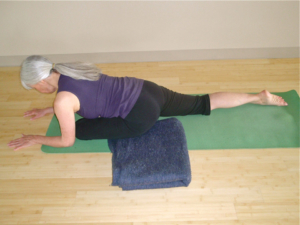This entry was posted on Oct 15, 2024 by Charlotte Bell.
 I didn’t want to do it. I’ve always enjoyed Kapotasana (Pigeon Pose), or at least the hip-opening variation that’s a preparation for Eka Pada Rajakapotasana (One-Legged King Pigeon). Many of my students like it too. For many years Pigeon Prep was a staple in my classes. When we’d practice vinyasa-style, it felt wonderful to swing forward from Adho Mukha Svanasana (Downward Facing Dog Pose) into Pigeon. It’s a smooth move that I miss.
I didn’t want to do it. I’ve always enjoyed Kapotasana (Pigeon Pose), or at least the hip-opening variation that’s a preparation for Eka Pada Rajakapotasana (One-Legged King Pigeon). Many of my students like it too. For many years Pigeon Prep was a staple in my classes. When we’d practice vinyasa-style, it felt wonderful to swing forward from Adho Mukha Svanasana (Downward Facing Dog Pose) into Pigeon. It’s a smooth move that I miss.
The Problem with Pigeon Pose
But the more I began to delve into hip health, the more I realize that Pigeon Pose is likely problematic for many practitioners. I’ve stopped teaching it. Here’s why:
- Pigeon Pose places a very strong asymmetrical force on the sacroiliac joints (SI joints). In Pigeon, the external rotators and abductors on front-leg side of the SI joint stretch, while the back-leg side of the SI joint compresses.
- Gravity. When the pelvis is off the ground or even barely grazing the ground in Pigeon, the weight of the torso amplifies the asymmetrical force on the SI joint.
- More often than not, the back leg’s position necessitates that the neck of its femur will press into the anterior border of the hip socket. Over time, this can wear down the labrum that rings the socket and the cartilage on the head of the femur.
- Tightness in the external rotators and abductors can transfer into the knee of the front leg, putting shearing pressure on the knee joint.
Can Pigeon Pose Be Saved?
Is there a way to rectify the problems with Pigeon Pose? In the past few years, before retiring the pose altogether, I suggested that everyone elevate the pelvis by sitting on a Yoga Block. This can relieve some of the problems. For some though, those whose hips are already off the floor, a block may or may not be high enough to prevent the weight of the torso from exacerbating the asymmetrical effects inherent in the pose. Also, there are practitioners who simply don’t want to use a block, and will practice the pose without it.
Kapotasana Alternatives
So what to do instead? Three options come to mind: Supta Ardha Padmasana (Supine Half Lotus), Gomukhasana (Cow Face Pose) and Agnisthambasana (Fire Log Pose). All three help relieve tension in the external rotators and abductors, but since both legs are in flexion in these poses, the action on the SI joint is much more symmetrical.
Of the two, Supta Ardha Padmasana is the safest choice for most people. Because it’s practiced lying down, it’s easier to keep track of the integrity of your spine. As always, it’s best to learn these poses from an experienced teacher who understands the importance of maintaining a healthy spinal position, and can teach you how to understand this for yourself.
Final Thoughts
Modern postural yoga seems to have a bit of an obsession with hip opening. While it’s important to maintain mobility in the hips—especially since so many of us spend lots of time sitting in chairs in front of a computer—stability is just as important. The practice of asana is not about becoming ever more flexible. It’s about balance—the balance between flexibility and stability. Hip-opening practice should always include hip stabilizing practice as well—standing balance poses and Utkatasana (Fierce Pose), for example.
As with all yoga practice, it’s helpful to remember that we’re not all cookie-cutter replicas of each other. There may, indeed, be some people for whom Pigeon Pose yields positive results. But in the context of a yoga class populated with varied body types, I don’t feel Pigeon is the healthiest choice.
About Charlotte Bell
Charlotte Bell discovered yoga in 1982 and began teaching in 1986. Charlotte is the author of Mindful Yoga, Mindful Life: A Guide for Everyday Practice and Yoga for Meditators, both published by Rodmell Press. Her third book is titled Hip-Healthy Asana: The Yoga Practitioner’s Guide to Protecting the Hips and Avoiding SI Joint Pain (Shambhala Publications). She writes a monthly column for CATALYST Magazine and serves as editor for Yoga U Online. Charlotte is a founding board member for GreenTREE Yoga, a non-profit that brings yoga to underserved populations. A lifelong musician, Charlotte plays oboe and English horn in the Salt Lake Symphony and folk sextet Red Rock Rondo, whose DVD won two Emmy awards.

